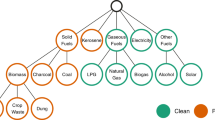Abstract
The type of energy system andindustrial structure of urban areas is veryimportant for the total amounts of Cu emitted.The total per capita emission for the New Yorkarea is estimated to be approximately 4 timeslarger than Stockholm municipality between 1900–1980. The latter was mainly the result of largedifferences in energy systems and industrialstructure. Hydro-electric power and non fossilfuels were important energy sources for Stockholmwhile coal was a much more significant fuel forthe New York area. Metal processing hascharacterised the industries of Stockholm whilethe New York area was a national centre forcopper and petroleum refining as well as thechemical industry. In both cases the estimated Cuemissions from fuel combustion and industrydecreased from 1900–1980. But in the case ofconsumption related emissions the time trendsdiffer between the two urban areas. In Stockholmend use was the largest category of Cu emissionsduring the whole time period studied. In the NewYork area consumption related emissions becamethe largest source of Cu emission in the 1950s.
Similar content being viewed by others
References
1914 års Industrikommission: Metall-och maskinavdelningen, kortregister över metallförbrukningen volym 493, Central Archives, Stockholm.
Arpi, G.: 1959, Sveriges skogar under hundra år: sammanfattande redogörelse över det svenska skogsbruket 1859–1959, Domänstyrelsen, Stockholm, Part 1, p. 199.
Ayres, R. U. and Rod, S. R.: 1986, Environment 28, 14–43.
Ayres, R. U. and McMichael, F. C.: 1987, ‘Measuring Toxic Chemicals in the Environment: A Materials Balance Approach’, Toxic Chemicals, Health, and the Environment, The John Hopkins University Press, Baltimore, U.S.A., p. 38.
Ayres, R. U., Ayres, L.W., Tarr, J. A. and Widgery, R. C.: 1988, An historical reconstruction of major pollutant levels in the Hudson-Raritan Basin: 1880–1980, NOAA Technical memorandum NOS OMA 43. 1: Summary, p. 25, 36–38, 2: Heavy metals and fossil fuels, p. 106.
Bergbäck, B.: 1992, ‘Industrial metabolism The emerging landscape of heavy metal immission in Sweden’, Ph.D. Thesis, Department of Water and Environmental studies, Linköping University, Linköping, Sweden, p. 36.
European Commission: 1992, Study of the Technical and Economic Aspects of Measures to Reduce Water Pollution Caused by Discharges from the Industrial Sectors Involved in the Surface Treatment of Metal, ISBN 92–827–5413–8, p. 14.
Gschwandtner, G., Gschwandtner, K. and Eldridge, K.: 1983, Historic emissions of sulfur and nitrogen oxides in the united states from 1900–1980, EPA-report, October 5.
Hallerdt, B.: 1992, Ljus kraft värme Energiförsörjning i Stockholm 1853–1992, Almqvist and Wiksell, Uppsala, pp. 3–4.
Kommerskollegium: Primäruppgifter industristatistiken, 1900–1963, Central Archives Stockholm.
Lohm, U., Bergbäck, B., Hedbrant, J., Jonsson, A., Svidén, J., Sörme, L. and Östlund, C.: 1997, Databasen Stockhome Flöden och ackumulation av metaller i Stockholms teknosfär, Linköping University, Department of Water and Environmental Studies, Tema V Rapport 25, p. 18, 95–109.
Miljöeffekter av ved-och torvförbränning: 1983, Statens Naturvårdsverk meddelande 1708, Solna, p. 52.
Naturmiljön i siffror (The Natural Environment in Figures): 1989, SCB, Stockholm (Statistics Sweden), p. 87.
Official Statistics of Sweden (Sveriges officiella statistik): National board of forestry (Skogsstatistisk årsbok) 1951, 1960, 1970, 1980.
Rod, S. R.: 1989, ‘Estimation of Historical Pollution Trends using Mass Balance Principles: Selected Metals and Pesticides in the Hudson-Raritan Basin, 1880–1980’, Ph.D. Thesis, Department of Engineering and Public Policy, Carnegie Mellon University, Pittsburgh, Pennsylvania, U.S.A., p. 46, 52–71, 129–133, 169–171, 176, 192.
SCB (Statistiska centralbyrån): Primäruppgifter till industristatistiken 1963–1980, Central Archives, Stockholm.
SOS (Statens Officiella Statistik): Handel, (Sweden's imports and exports by commodities and counties), Central Bureau of Statistics, Stockholm.
SOS (Statens Officiella Statistik): Industri, (Manufacturing) Central Bureau of Statistics, Stockholm.
Tarr, J. A. and Ayres, R. U.: 1990, ‘The Hudson-Raritan Basin’, in B. L. Turner (ed.), The Earth as Transformed by Human Section Global and Regional Changes in the Biosphere over the Past 300 Years, Cambridge University Press, Cambridge, p. 628, 632–633.
Author information
Authors and Affiliations
Rights and permissions
About this article
Cite this article
Svidén, J., Hedbrant, J., Lohm, U. et al. Copper Emissions from Fuel Combustion Consumption and Industry in Two Urban Areas 1900–1980. Water, Air, & Soil Pollution: Focus 1, 167–177 (2001). https://doi.org/10.1023/A:1017560306168
Issue Date:
DOI: https://doi.org/10.1023/A:1017560306168




